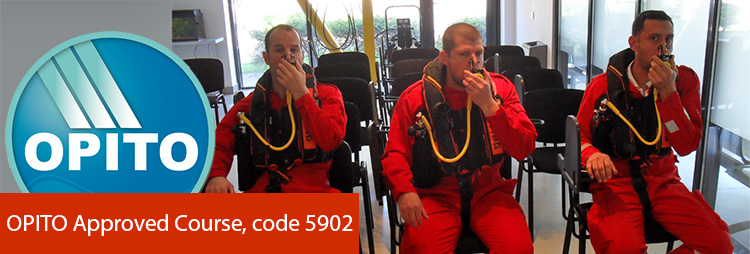
CA-EBS Initial Deployment Training (CA-EBS)
The OPITO-approved Compressed Air Emergency Breathing System (CA-EBS) Initial Deployment training programme is designed for personnel travelling to or from offshore installations/vessels via helicopter where a Compressed Air Emergency Breathing System will be provided for use in the case of an emergency ditching.
Target Group for the CA-EBS
The Target group is personnel that are issued with Compressed Air Emergency Breathing System (CA-EBS) whilst travelling to work by helicopter and may be required to use a CA-EBS in the event of an emergency.
Delegate pre-requisites for the CA-EBS
Delegates must possess a valid BOSIET/FOET certificate including a valid HUET certificate prior to attending the OPITO Compressed Air Emergency Breathing System (CA-EBS) Initial Deployment Training programme.
Physical and stressful demands of the CA-EBS
Training and/or assessment activities contained within this Standard may include physically demanding and potentially stressful elements. All personnel who participate in such activities must be physically and mentally capable of participating fully.
Before be accepted on the Course, the candidate will present:
a. A valid, current offshore medical certificate or similar
b. A valid medical certificate for aviation or marine personnel
Duration of the CA-EBS
Tre course duration is 90 minutes.
Aim of the CA-EBS
The aims and objectives of the training are to ensure that the delegate gains the required knowledge and understanding of the particular hazards and properties of a Compressed Air Emergency Breathing System (CA-EBS) and appropriate practical emergency response actions to take should the requirement for emergency deployment arise.
Learning outcomes of the CA-EBS
To successfully complete this training delegates must able to explain:
1. The fundamental differences between re-breather and compressed air systems (technology and use)
2. The rationale and use of compressed air emergency breathing systems in helicopter emergency situations
3. The hazards associated with compressed air emergency breathing systems
To successfully complete this training delegates must able to demonstrate:
1. A pre-flight inspection of the life jacket and CA-EBS
2. Donning the life jacket with CA-EBS correctly, including "buddy check"
3. An emergency deployment of the CA-EBS in a dry environment


CA-EBS Key Facts
- The Sea Survival School was founded in 2010 as a part of the Regional Air Services and is OPITO certified – starting with 7th of February 2011
- OPITO is a non-profit organization, owned by the offshore industry aiming at rising the competence and safety at work
- All OPITO certificates are placed in VANTAGE system – which all operators can access on-line to check records authenticity
- For more information, please visit the Sea Survival School's website: www.sea-survival.ro
